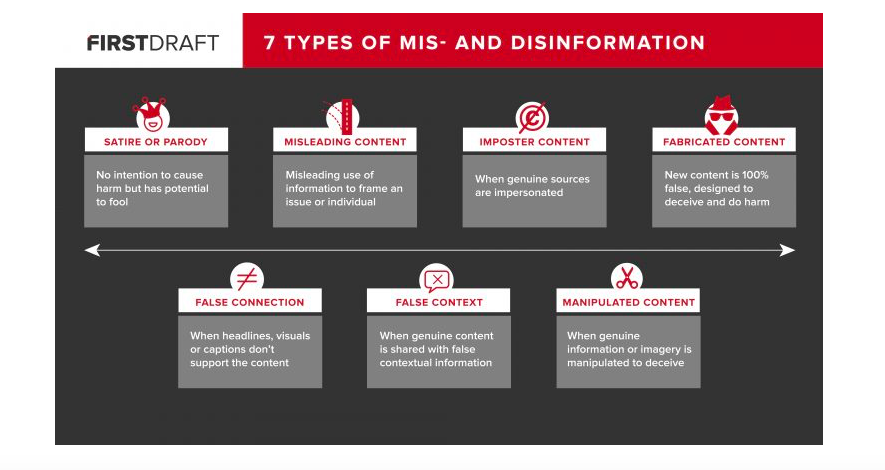“If we define literacy as the ability to read (or interpret) the world around us, then digital literacy should not be thought of as requiring a separate set of skills. Rather, digital literacy ads a layer to traditional literacy, enabling us to read or interpret the connected reality we live in.” (Couros and Hildebrandt, 2017)
But how should we read in our digital world and what should we believe? After I tested myself using the experiment my classmate, Rob Gareau included in his content catalyst, I realized that I was having a hard time differentiating between fake and true information.

One might ask: What is fake news? As Claire Wardle in First Draft describes, fake news can be several things, such as: click bait, authentic content moved to a misleading context, imposter sources designed to look like reliable sources we already know, false information meant to stir outrage, satire or parody, and news that you personally disagree with. Fake news can be created for two different reasons: misinformation, that can be intentional or non-intentional, and disinformation providing inaccurate information intentionally.

As Nancy Smith in her content catalyst points out, the social media platforms play a role in distributing fake news as well. Although social media does not produce any content, it is still responsible for distributing information based on algorithmic and AI dicisions. An algorithm is a set of rules used to rank, filter and organize the content for users based on their actions and preferences. Through feeds, social media influences the information that we see, and they aim to personalize the content for us.
In order for us to be better informed, we need to learn skills to read critically and decipher information. Without fact checking, as Claire Wardle says “we are adding to the pollution of our information ecosystem”. It is crucial to support quality information by being critical of the information we consume.
How can we sort truth from fiction though, when lies and facts are side by side? According to Mike Caulfield a set of skills are needed, such as reading laterally in order to be able to judge websites. Lateral reading is an important piece of digital literacy. In order to acquire this valuable skill, students need to see examples and practice identifying them to be able to find better information and be better informed. My classmate, Christina Patterson, points out in her content catalyst, that just as in teaching literacy where teachers focus on the difference between fiction and non-fiction, students need to be taught the difference between fake news and true information. Canada’s National Observer Guide identifies 5 steps when it comes to spotting fake news:
- confirm the source
- check the facts
- quality counts
- read before you share
- speak up
Just to name a few, factscan.ca and snopes.com can also be used for fact checking. Erin Wilkey Oh in The Future of Fake News is encouraging us to teach our students essential questioning as well: Who created this message? Why is this message being sent? Why was it made? Where is the message being distributed? Which techniques are used to attract my attention? Which lifestyles, values and points of view are represented or missing? (Oh, Dec 12, 2017)
Eli Pariser is teaching us to be sceptical and approach everything by questioning its truth. Because of the data literacy and algorithmic literacy curating the world for us, what we see online is “only one slice of the pie and one that’s been cut specifically for you.” Eli Pariser calls this the “filter bubble”, the media world we create where we only see and interact with things and people we already like, causing us to fall into traps all the time because we like when things are comfortable, certain and easy. In order to avoid being “isolated in a web of one” what we need is to see things that are relevant, important, uncomfortable, challenging and other points of view.
Thank you for stopping by!
Melinda
